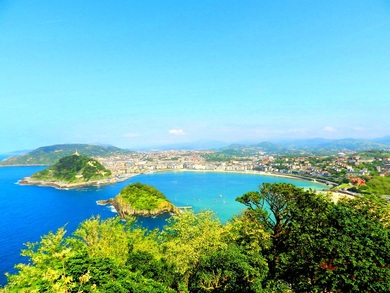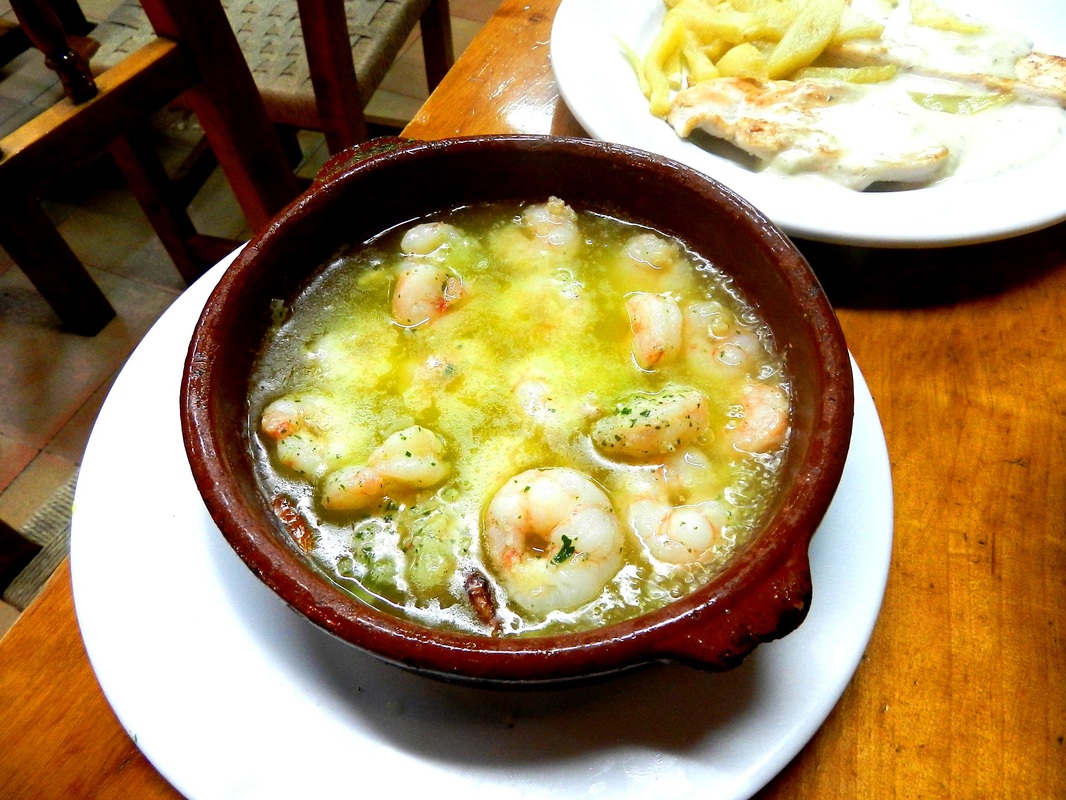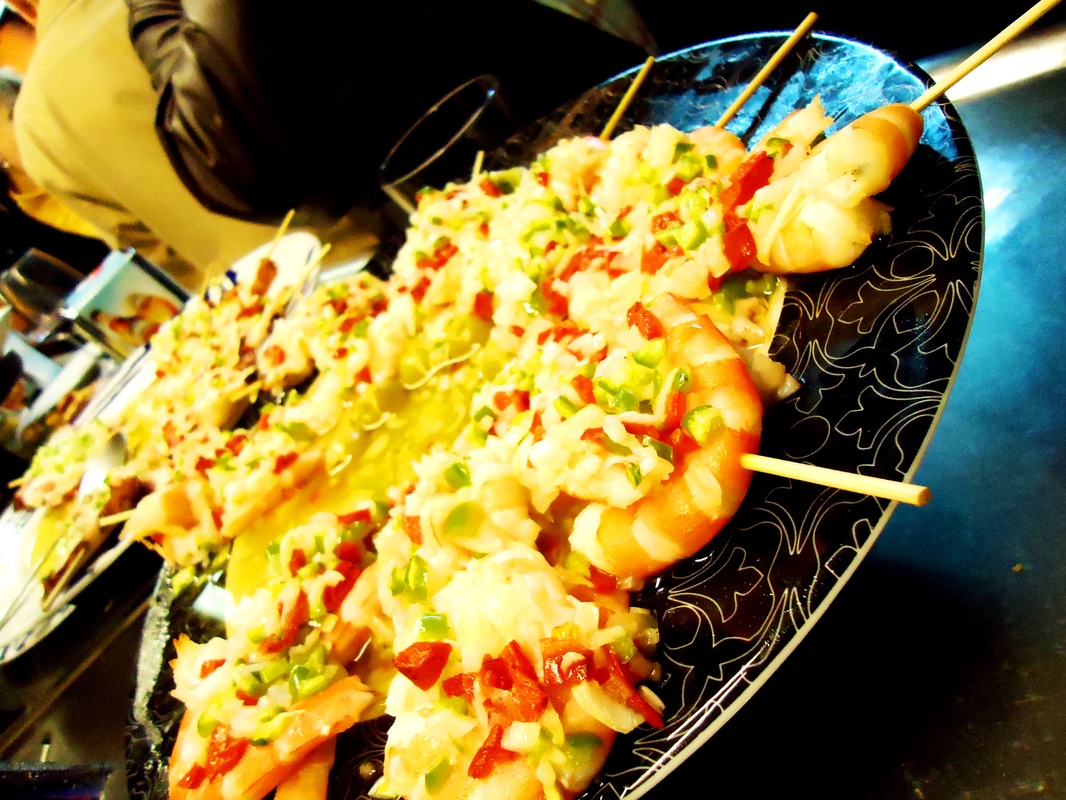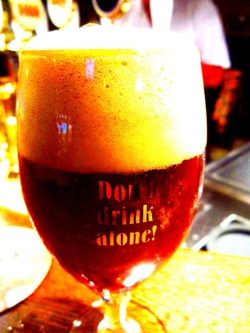 Petronas Towers, a modern landmark Emerging as one of the stronger ASEAN capitals, Kuala Lumpur, along with its neighbor Singapore, has been praised for being one of those functional and "the system is working" type of cities which balance steady economic growth with infrastructure development for the people. KL offers a balanced and attractive working environment, positive enough to draw foreigners not just to invest in KL but to actually work and base themselves in KL. The comparison to KL (and Singapore) by my own city, Manila, often ends in shaking heads and puzzlement - how could such growth have been possible and how Manila could "catch up".
For me, this is all "meaningless" in the travel-culture sense and I knew nothing and expected nothing from KL, except that I saw it as a place that's probably similar to Singapore but with "more culture per capita". A long-layover last December allowed me to see if this is so...
 Lovely jamon y queso de cabra pintxos In my previous post, I started to chronicle some of my food adventures in San Sebastian, Spain - the star gastronomic city of the proud Basque country; a bit low on the radar for anything else other than food, this is certainly a to-visit destination for foodies coming to Europe. There are numerous ways of experiencing Basque cuisine: in restaurants serving up classic Basque food (often with special week-end offers), in other food venues like sagardotegi (Basque cider houses) from which one can enjoy both a nice txuleta (steak) and natural cider or, if price is not an issue, by going to modern gastronomic venues by this and that chef. Easily the most popular and the most affordable way of enjoying delectable Basque treats, however, is by going for pintxos, the elevated Basque form of the popular tapas culture that evolved from southern Spain. Indeed, it is with pintxos that the Basques have dominated Spanish cuisine and which has earned their fame across the rest of Spain for stylized presentations (not necessarily with "sticks" or pintxos, in Spanish) that elevate their food. Being that it was my second time in the city, there was no way I was gonna let the opportunity to go for some nice pintxos pass (indeed, I ended up sampling quite a bit). Indeed, I got to be more selective with my choice of places now by surveying the favorites (scouting online reviews, in advance, as well). And need I say that it was a tasty and colorful journey.
 View of the moon-shaped Playa de la Concha from Monte Igeldo Considered the gastronomic capital of Spain and located at the Atlantic coast of the proud Basque country ( Euskal Herria), San Sebastian is a city that is proud of its cuisine. Taking inspiration from both French and Spanish sides of the Basque, the local environs and, most importantly, the season, Basque food is famous for highlighting the best ingredients from the area and of the season and manipulating it into real masterpieces, often impressive to look at and even better to taste. Being that it was my second time to visit the city (having been there for a few days a couple of years ago), I had an idea about what I was plunging into - an amazing pintxos culture in La Parte Vieja (Old Town), a wide selection of seafood (some of which are not found easily in the Mediterranean) and the Spanish penchant for wine and enjoyment but little did I know that I would be in for much more. Having refined my choices on where to go (both from experience and from the internet), I was in for a weeks' worth of treats! In this post, I'll chronicle mostly my adventures with Basque cuisine, in the more general sense, and particularly with my encounters of Basque dishes in restaurants - I'll reserve my review and selection of pintxos (an even more elaborate aspect of Basque cuisine ) on another post.
This the first of many filler articles to come. Filler articles are short posts that I could quickly scribble and compose to keep a steady stream of information sharing when I'm busy writing blog posts as well as other things. As my hands are full in writing blog posts now (there are at least 3 under work), I decided to give the filler thing a go.
First, a short update on what I've been up to -- currently recovering from the short 2-day trip to Budapest that I did last weekend (more on that on a coming blog post) while also prepping for another trip for this coming weekend, an official one, this time to Spain... in the Basque country (up in the northern Atlantic coast, near the French border). Since I'm somewhat excited to do this trip (even if I've been there before, a couple of years ago), I'm writing a filler to share something which I'm looking forward to -- food-related, of course!
The Basque country (in particular, San Sebastian, one of its two main cities) is an important gastronomic center not just in Spain but also in Europe (boasting of being the city with the most Michelin-starred restaurants per capita in Europe) - a fact that manifests in their participation in developments on modern cooking (nueva cocina or cuisine nouvelle) that can be sampled in their fine-dining posh restaurantes as well as in more accessible food options such as pintxos - the Basque equivalent of the Spanish tapas.  Gambas al ajillo (Shrimp in garlic), a classic tapa one can find almost anywhere in Spain (this one is from Sevilla) |  Shrimp and fish paté on top of a piece bread, a classic pintxo in the Basque country (this one is from San Sebastian) |  Skewered shrimp with chopped bell peppers, onions and light vinaigrette, another pintxo (again, from San Sebastian) |
 "Don't drink alone!" ... oops, too late! Trying out beer ( pivo, in Czech) is probably one main reason to travel to the Czech republic. The country not only boasts of having the largest beer consumption per capita in the entire world but also of being the source for some of the world's most popularized brews -- Pilsen and Budweiser, two crisp lagers that are chugged in more places than one can enumerate. I myself was never a beer fan - I found beer back home terrible (and could only drink some brews like Red Horse and San Mig's Cerveza Negra) and while the options in Italy were slightly better ( Peroni, Nastro Azzurro, Heineken), it was easier to prefer wine. This changed after learning about Belgian beer (in this specialty pub I found in Naples) and after going to Belgium itself. Hands down, Belgium won my heart with beer (from the commercial brews to the rarer trappist ones made by monks) and I always thought it would be hard to challenge Belgium's standard. After trying my first mug of Czech beer (a Pšeničné pivo or weissbier with a slice of lemon), I was won over - this place could give Belgium a run for its money. Still, four days and four nights of chugging beers (and one can really only drink so much) doesn't make one an expert and what this experience of beer degustation really just did was pique my interest on the subject. That being said, I believe I still picked up quite a few things about Czech beer from my first hand experience of going around the country and drinking all the beer that I can -- one's gut can only hold so much liquid and, further, since I was traveling alone (for personal security).
|








 RSS Feed
RSS Feed